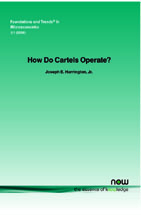How Do Cartels Operate?
By Joseph E. Harrington Jr., Department of Economics, Johns Hopkins University, USA, joe.harrington@jhu.edu
Abstract
This paper distills and organizes facts about cartels from about 20 European Commission decisions over 2000–2004. It describes the properties of a collusive outcome in terms of the setting of price and a market allocation, monitoring of agreements with respect to price but more importantly sales, punishment methods for enforcing an agreement and also the use of buy-backs to compensate cartel members, methods for responding to external disruptions from non-cartel suppliers and handling over-zealous sales representatives, and operational procedures in terms of the frequency of meetings and the cartel's organizational structure.
How Do Cartels Operate?
What does cartel behavior look like? How is it distinguishable from competitive behavior? How Do Cartels Operate? answers these questions by examining cartels and exploring how they operate. It describes a collusive outcome in terms of price and an allocation of market supply, how a collusive outcome is monitored and enforced, and how a cartel's organizational structure is designed. How Do Cartels Operate? provides an understanding of how cartels operate and generates a rich set of collusive markers based on market data. In addition, this analysis has implication for future directions in the theory of cartels. By identifying empirical regularities and institutional features of hard-core cartels, this can be used to guide theoretical modeling. How Do Cartels Operate? describes cartel behavior and provides a behavioral screening approach to identify patterns in market data consistent with a cartel operating. It is an invaluable resource for policy-makers in regulatory environments and researchers studying the industrial organization of cartels.
